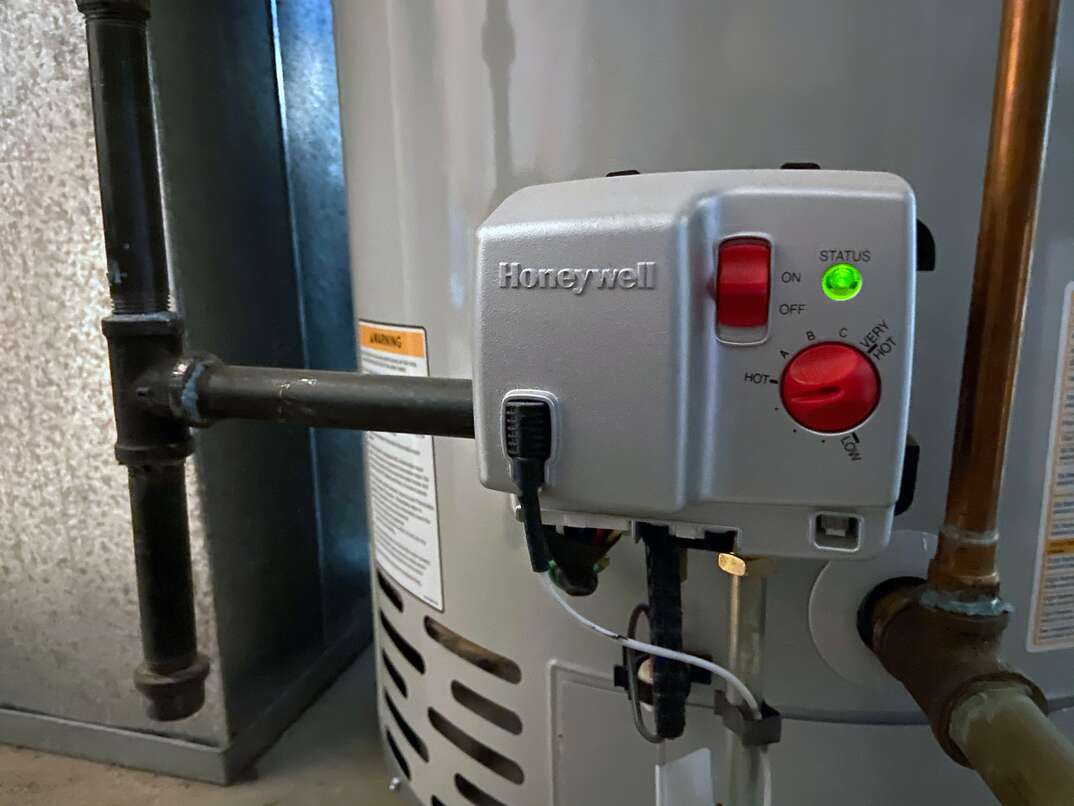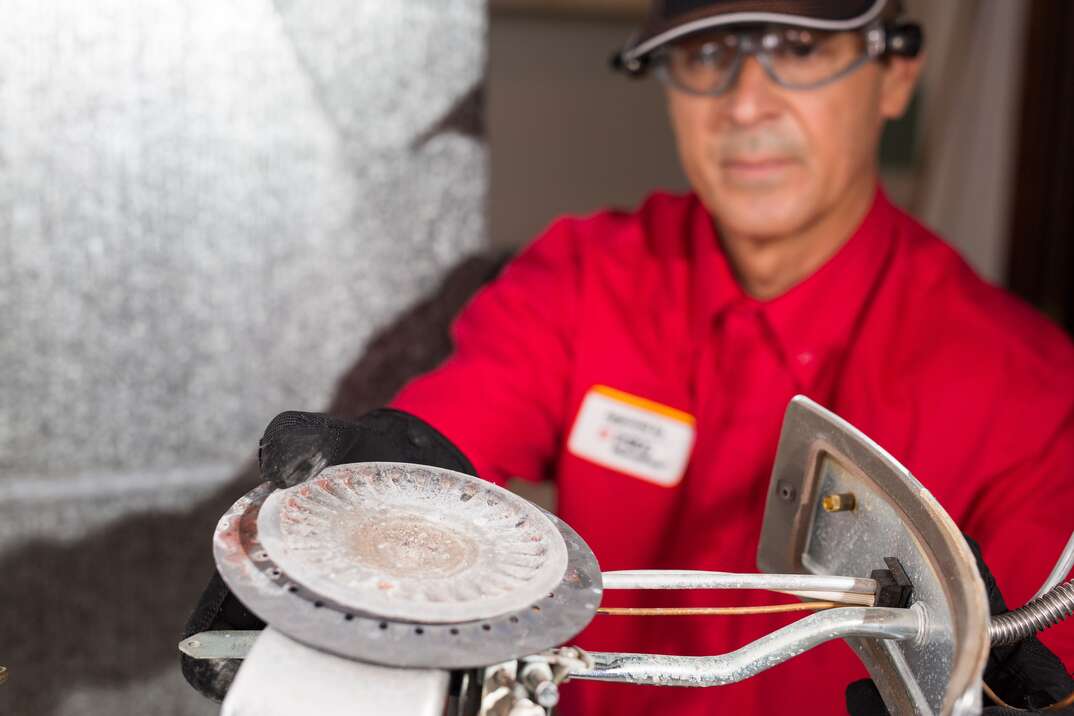How To Check A Water Heater Element
Testing a H2o Heater Element at a Glance
- Tools: Screwdriver, digital multimeter, non-contact voltage tester (optional)
- Stride i: Shut off power
- Pace 2: Remove metal covers
- Pace 3: Take out insulation
- Step 4: Locate heating element
- Stride five: Verify electricity is off
- Step 6: Check element with multimeter
- Step 7: Reassemble water heater
Among the several possible reasons your water heater isn't producing hot water, a faulty heating element is ane of the most common. Fortunately, testing the heating chemical element is 1 of the easiest diagnostic tests you tin can do yourself. You don't need to bleed the tank or mess with any gas, water or electric lines.
This May Also Interest Y'all: How Do I Turn My Water Heater On
Earlier you lot shell out the big bucks for professional repair — or full replacement — of your water heater, have the following steps to run into if the heating element is the culprit.
Signs of a Bad H2o Heater Element
As easy as information technology is to test the chemical element, information technology's a good idea to know the near common signs of a bad heater element to make up one's mind whether testing information technology is even warranted. Symptoms of a bad heater chemical element include:
- Lukewarm water
- Pocket-size amount of hot water
- No hot water
- Hot water runs out faster than usual
- H2o heater's excursion breaker constantly trips
Virtually full-sized residential water heaters have 2 heating elements (elevation and lesser), but smaller water heaters may simply have 1. For water heaters with two elements, each one serves a slightly different purpose. Consequently, you can usually make up one's mind which chemical element has failed based on the specific symptoms yous're experiencing.
Symptoms of a Bad Upper Heating Element:
- No hot water
- Hot water doesn't reach the temperature set on the thermostat
Symptoms of a Bad Lower Heating Chemical element:
- Small corporeality of hot water
- Hot h2o runs out faster than usual
If you're experiencing whatsoever of these symptoms, y'all can exist fairly confident testing the elements won't be a waste material of time.
Tools Required
- Screwdriver
- Digital multimeter
- Non-contact voltage tester (optional)
How to Test the Element

Step one. Shut off the Power
Since testing the heater element involves working with electricity, it's important to plow off power to your water heater to ensure safe working weather. To exercise so, you need to shut off the circuit breaker that powers the water heater. This excursion breaker volition be located in your habitation's central billow box, a 1-foot by 2-pes metallic box commonly located in the garage, basement or under a stairway.
The electrician who wired your habitation should have labeled which breaker goes to your water heater inside of the breaker box. Turn off the breaker that corresponds to your h2o heater past flipping it to the side marked "off." If the breaker isn't labeled, either shut the power off to your unabridged home with the primary billow (usually located at the peak of the box) or turn off all the double breakers — those that have two breakers linked together.
Stride 2. Remove the Metal Covers
At that place should be one or two metallic plate covers on the side of your water heater. These covers house the thermostat and heater element and are held in place by two or more screws that usually take Phillips heads. Remove these screws with a screwdriver or power drill with the appropriate chip.
Step 3. Remove the Insulation and Plastic Covers
Most water heaters have a layer of insulation and a thin plastic shield between the metal cover and heater element. The insulation tin can either be a rigid foam or flexible fiberglass insulation. You lot should exist able to remove foam insulation past paw in one piece, but it may accept to be pried or cutting out in some cases. Fiberglass insulation may need to be carefully cut away with a utility pocketknife.
The plastic shield is usually clipped into metal tabs on the h2o heater. It should snap out afterward pulling with light to moderate pressure. Care should be taken not to damage either of these components since they volition be reinserted afterwards your test has been completed.

Stride 4. Locate the Heating Element
The thermostat and heating element should now be visible. The thermostat is oft rectangular with several electrical wires connected to screws on either side of information technology. It's located above the heating element.
The bodily heating chemical element is inside the tank. The visible portion is the approximately i-inch square base of operations (or "end betoken") with two screws that have electric wires running to them. These two screws are where you will be performing your test.
More Related Articles:
- How to Relight Your Water Heater'due south Pilot Light
- Don't Forget to Flush! A 6-Pace Guide for Flushing Your Gas or Electric Water Heater
- A Tankless Chore? Decide Whether a Tankless H2o Heater Works for Your Dwelling house
- What'due south a Smart Water Heater?
- 7 Tell-Tale Signs of a H2o Heater Non Working
Step 5. Verify the Electricity Is Off
Confirm the power is off with a non-contact voltage tester or a multimeter. A non-contact voltage tester is a device shaped like a pen that volition illuminate or beep when in shut proximity to an electrically charged ("alive") wire. It simply needs to be placed near the electrical wires running to the thermostat and heater element to determine the electricity is off. If it lights upward or beeps, that means the wires are still alive and the electricity wasn't properly close off.
To test with a multimeter, plow the dial to the setting for alternating electric current, which is usually displayed equally "5~." Touch the carmine probe to one screw and the black probe to the other spiral. Y'all should not exist registering any electricity. If yous meet a reading of 110 to 130, that means in that location is still electricity going to the h2o heater. Test again afterward switching the probes around. Place the red probe on the spiral where you had the blackness probe previously, and the blackness probe where y'all had the red probe. Doing and so will assistance to ensure you're getting a reliable reading.
Step six. Bank check the Heater Element With Your Multimeter
The functionality of a heating chemical element is determined by the resistance in the circuit, which is measured in ohms (Ω). Plow the dial of your multimeter to the lowest ohms setting. Touch the cherry probe to the heart of one of the heating chemical element screws and the black probe to the other spiral. It doesn't affair which probe touches which screw when measuring the resistance.
If the heating element is working correctly, your multimeter should read somewhere between 10 and xxx Ω. If the reading is beneath that (i.e., 0 or 1), your heating chemical element is faulty and needs to be replaced. Repeat this step on the other heating chemical element if your water heater has ii.
Step seven. Reassemble the Water Heater
Whether your heating elements are working properly or you lot replaced a faulty one, it's time to reassemble your h2o heater. Reinstall the plastic encompass over the heating chemical element (if equipped), and reinsert the insulation. Finally, plow the water heater's breaker dorsum on. If you replaced a heater element, yous might accept to wait a few hours for the water to heat up and so you lot can ostend your repair was successful.
How To Check A Water Heater Element,
Source: https://www.homeserve.com/en-us/blog/how-to/test-water-heater-element/
Posted by: rowlandamited.blogspot.com


0 Response to "How To Check A Water Heater Element"
Post a Comment